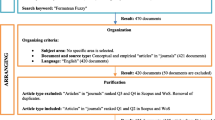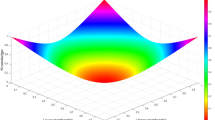Abstract
An Interval-valued trapezoidal intuitionistic fuzzy set (IVTrIFS) is a powerful tool for modelling uncertainty. The ranking of IVTrIFSs plays a vital role in fuzzy set theory to compare and analyze the given information. An IVTrIFS is a special type of Intuitionistic Fuzzy Set (IFS) and interval-valued intuitionistic fuzzy set (IVIFS) with a consecutive domain of real numbers. In this paper, we analyzed many ranking methods based on various Fuzzy logic techniques and proposed a new ranking method from geometric point of view, the expectation and expectant score function of an IVTrIFS from the concept of centroids of the membership function, non-membership function, and hesitancy function. The comparative results show that the proposed method is innate and effective, very useful to the applications of computational Intelligence, decision-making, predictive system analysis, and performance analysis.


Similar content being viewed by others
References
Zadeh LA. Fuzzy sets. Inf Comput. 1965;8:338–53.
Atanassov KT. Intuitionistic fuzzy sets. Fuzzy Sets Syst. 1986;20(1):87–96.
Jamkhaneh EB, Nadarajah S. A new generalized intuitionistic fuzzy set. Hacettepe J Math Stat. 2015;44(6):1537–51.
Atanassov K, Gargov G. Interval-valued intuitionistic fuzzy sets. Fuzzy Sets Syst. 1989;31(3):343–9.
Sahoo KK, Hazra R, Ijaz MF, Kim S, Singh PK, Mahmud M. MIC_FuzzyNET: fuzzy integral based ensemble for automatic classification of musical instruments from audio signals. IEEE Access. 2022. https://doi.org/10.1109/ACCESS.2022.3208126.
Sahoo KK, et al. TLEFuzzyNet: fuzzy rank-based ensemble of transfer learning models for emotion recognition from human speeches. IEEE Access. 2021;9:166518–30.
Gaur L, et al. Disposition of youth in predicting sustainable development goals using the neuro-fuzzy and random forest algorithms. Human-Centric Comput Inf Sci. 2021;11:24.
El-Sappagh S, et al. An ontology-based interpretable fuzzy decision support system for diabetes diagnosis. IEEE Access. 2018;6:37371–94.
Ali F, et al. A smart healthcare monitoring system for heart disease prediction based on ensemble deep learning and feature fusion. Inf Fusion. 2020;63:208–22.
Ali F, et al. A fuzzy ontology and SVM-based Web content classification system. IEEE Access. 2017;5:25781–97.
Jamkhaneh EB. New interval value intuitionistic fuzzy sets. Res Commun Math Math Sci. 2015;5(1):33–46.
Kumar G, Bajaj RK. On solution of interval valued intuitionistic fuzzy assignment problem using similarity measure and score function. Int J Math Comput Phys Electr Comput Eng. 2014;8(4):715.
Halder S, Biswapati J. Application of fuzzy programming techniques to solve solid transportation problem with additional constraints. Oper Res Decis. 2020;30(1):67–84.
Roszkowska E. The extension of rank ordering criteria weighting methods in fuzzy environment. Oper Res Decis. 2020;30(2):91–114.
WahedKhalifa HA. Goal programming approach for solving heptagonal fuzzy transportation problem under budgetary constraint. Oper Res Decis. 2020;30(1):85–96.
Dong J-Y, Wan S-P. Interval-valued trapezoidal intuitionistic fuzzy generalized aggregation operators and application to multi-attribute group decision making. Scientia Iranica E. 2015;22(6):2702–15.
Sireesha V, Anusha V, S.N. Murty K,. A distance measure approach to rank Interval-valued Intuitionistic Trapezoidal fuzzy sets. Math Stat Eng Appl. 2022;71(4):4335–53.
Sireesha V, Himabindu K. An ELECTRE approach for multi-criteria interval-valued intuitionistic trapezoidal fuzzy group decision making problems. Adv Fuzzy Syst. 2016;2016:1956303. https://doi.org/10.1155/2016/1956303.
Jamkhaneh EB, Saeidifar A. New generalized interval valued intuitionistic fuzzy numbers. Theor Approx Appl. 2018;12(1):43–64.
Shu MH, Cheng CH, Chang JR. Using intuitionistic fuzzy sets for fault tree analysis on printed circuit board assembly. Microelectron Reliab. 2006;46(12):2139–48.
Li DF. A Note on using intuitionistic fuzzy sets for fault-tree analysis on printed circuit board assembly. Microelectron Reliab. 2008;48(10):1741.
Wang JQ. Overview on fuzzy multi-criteria decision making approach. Control Decis. 2008;23(6):601–7.
Wan SP. Multi-attribute decision making method based on interval intuitionistic trapezoidal fuzzy number. Control Decis. 2011;26(6):857–61.
Wu J, Liu YJ. An approach for multiple attribute group decision making problems with interval valued intuitionistic trapezoidal fuzzy numbers. Comput Ind Eng. 2013;66:311–24.
Funding
Funding information is not applicable/ No funding was received.
Author information
Authors and Affiliations
Corresponding author
Ethics declarations
Conflict of interest
K. S. N. MURTY declares that he has no conflict of interest. V. SIRISHA declares that she has no conflict of interest.
Ethical Approval
This article does not contain any studies with human participants or animals performed by any of the authors.
Additional information
Publisher's Note
Springer Nature remains neutral with regard to jurisdictional claims in published maps and institutional affiliations.
Rights and permissions
Springer Nature or its licensor (e.g. a society or other partner) holds exclusive rights to this article under a publishing agreement with the author(s) or other rightsholder(s); author self-archiving of the accepted manuscript version of this article is solely governed by the terms of such publishing agreement and applicable law.
About this article
Cite this article
Kodukulla, S.N.M., Sireesha, V. A Novel Ranking Approach to Rank Interval-Valued Trapezoidal Intuitionistic Fuzzy Sets by Using the Concept of Centroids. SN COMPUT. SCI. 5, 493 (2024). https://doi.org/10.1007/s42979-024-02861-x
Received:
Accepted:
Published:
DOI: https://doi.org/10.1007/s42979-024-02861-x




